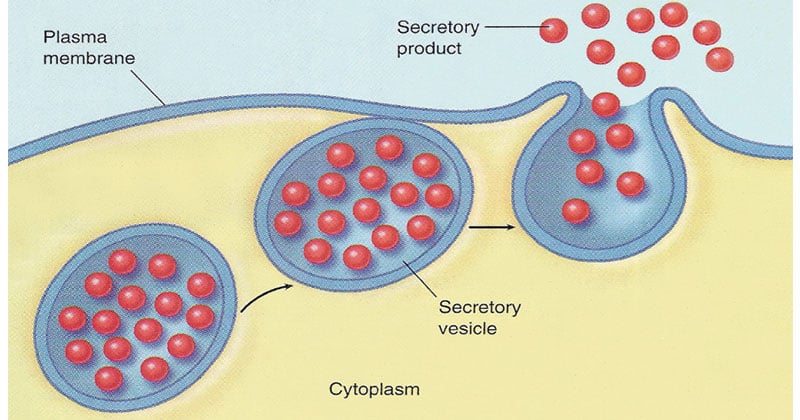Interesting Science Videos
Secretory Vesicles Definition
- Vesicles are small, membrane-enclosed sacs that store and transport substances to and from one cell to another and from one part of a cell to another.
- The small, spherical compartment of vesicles is separated from the cytosol by at least one lipid bilayer.
- Because vesicles are made of phospholipids, they can break off of and fuse with other membraneous material.
- Thus, vesicles can fuse with the plasma membrane when they want to release their contents outside the boundaries of the cell.
- However, vesicles can also fuse with other organelles that are present inside the cell to release or engulf substances.
- The function of vesicles in a cell, thus, varies depending on the type of vesicle that is present.

Figure: Diagram of Secretory Vesicles
Introduction
- It contains materials that are to be excreted from the cell.
- These may be materials harmful to the cell such as waste products or end products of reactions in the cell, and hence, there is a need to get rid of it.
- However, it may even contain many useful secretions that are needed in different parts of the body such as hormones.
- Thus, the secretory vesicle is a vesicle that mediates the vesicular transport of cargo – e.g. hormones or neurotransmitters – from an organelle to specific sites at the cell membrane, where it docks and fuses to release its content.
- It has been demonstrated that membrane-bound secretory vesicles dock and fuse at porosomes, which are specialized supramolecular structures at the cell membrane.
- It include synaptic vesicles and vesicles in endocrine tissues.
Types
a. Synaptic Vesicles
Synaptic vesicles store neurotransmitters. They are located at presynaptic terminals in neurons. When a signal reaches the end of an axon, the synaptic vesicles fuse with the cell membrane and release the neurotransmitter. The neurotransmitter crosses the synaptic junction and binds to a receptor on the next cell.
b. Vesicles in Endocrine Tissues
Some cells also produce molecules, such as hormones produced by endocrine tissues, needed by other cells. The hormones that are secreted from the endocrine glands are also stored in secretory vesicles, from where they are released into the bloodstream when needed.
Working of Synaptic Vesicles
- The release of proteins or other molecules from a secretory vesicle is most often stimulated by a nervous or hormonal signal.
- The membrane of the vesicle can then fuse with the membrane of the target cell and essentially spill its contents.
- The vesicle then adds its membrane to that of the target cell.
- This is typically temporary until another vesicle is created when certain components are then removed from the cell.
For example, a nerve cell impulse triggers the fusion of secretory vesicles to the membrane at the nerve terminal, where the vesicles release neurotransmitters into the synaptic cleft (the gap between nerve endings). The action is one of exocytosis: the vesicle and the cell membrane fuse, allowing the proteins and glycoproteins in the vesicle to be released to the cell exterior.
As secretory vesicles fuse with the cell membrane, the area of the cell membrane increases. Normal size is retained by the reuptake of membrane components through endocytosis. Regions bud in from the cell membrane and then fuse with internal membranes to affect recycling.
Functions of Secretory Vesicles
- Secretory vesicles in the regulated secretory pathway carry soluble proteins, peptides or neurotransmitters and are actively transported to selected subcellular domains for extracellular delivery in response to a specific extracellular signal.
- In addition to transportation, secretory vesicles can store or digest certain secreted molecules.
- Synaptic vesicles store neurotransmitters, hormones are stored in secretory vesicles for release into the bloodstream, and enzymes are also stored in secretory vesicles to be used when needed to make cell walls in certain plants, fungi, and bacteria.
References
- Verma, P. S., & Agrawal, V. K. (2006). Cell Biology, Genetics, Molecular Biology, Evolution & Ecology (1 ed.). S .Chand and company Ltd.
- Alberts, B. (2004). Essential cell biology. New York, NY: Garland Science Pub.
- https://www.ncbi.nlm.nih.gov/books/NBK9886
- https://www.ck12.org/biology/Vesicles-and-Vacuoles/lesson/Vesicles-and-Vacuoles-Advanced-BIO-ADV/
- https://study.com/academy/lesson/vesicles-definition-function-quiz.html
- https://bio.libretexts.org/TextMaps/Introductory_and_General_Biology/Book%3A_General_Biology_(Boundless)/4%3A_Cell_Structure/4.4%3A_The_Endomembrane_System_and_Proteins/4.4A%3A_Vesicles_and_Vacuoles
- https://www.abcore.com/secretory-vesicles
- https://courses.lumenlearning.com/boundless-biology/chapter/the-endomembrane-system-and-proteins/
- https://biologywise.com/vesicle-function
- https://www.sciencedirect.com/topics/neuroscience/secretory-vesicles
